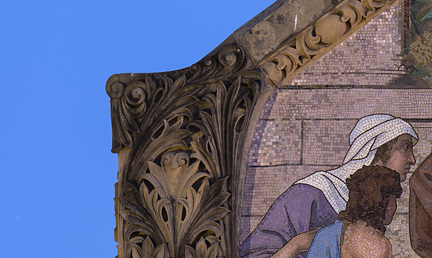Crosshatching Pattern Noise in Adobe Camera Raw AI Denoise Seems to be Fixed, Plus Base ISO in Low Light
Adobe Camera Raw AI Denoise always also includes Enhance Details for a double heaping helping of Good Stuff, seemingly. Wow!
I went back to reproduce the ugly crosshatching pattern noise issue using the same raw file as back then. I am unable to reproduce the issue, so it is apparently fixed. That frees up the full potential of ACR AI Denoise and Enhance Details, pretty awesome!
What follows are crops from the Fujifilm GFX100 at ISO 100. The crops are at 2X enlargement to make it easier to see the differences.
The results establish that Adobe Camera Raw AI Denoise has clear benefits even at base ISO, at least for exposures where the noise level is significant such as long exposures (or underexposure). And no apparent negative effects that I have noticed so far.
Toggle to compare.
Crop1
Smooth areas like sky are massively improved, with noise eliminated. Details are subtly enhanced, though in some places the elimination of the noise makes the image looks subtly less sharp.

Fujifilm GFX100 + Fujifilm GF 110mm f/2 R LM WR @ 90.5mm equiv (110mm) RAW: scaled 200% linearly PD2.0
[low-res image for bot]
Crop2
In most areas, the differences are relatively subtle: certain details see contrast improvements, noise is reduced which can make details look slightly less sharp.

Fujifilm GFX100 + Fujifilm GF 110mm f/2 R LM WR @ 90.5mm equiv (110mm) RAW: Enhance Details, scaled 200% linearly PD2.0
[low-res image for bot]
Per K writes:
I tested it and compared it with my standard denoise tool: Topaz Denoise AI. Yes the Adobe is effective though in comparison quite slow. Topaz has another advantage as you can create masks. In many cases I avoid noise reduction in areas with much detail - or apply less noise reduction to those areas.
Both AI programs do very well not to destroy the very sharpest areas! In my test I noticed that smooth areas yet with some detail (used a bird photo) tended to be looking a bit like plastic.
Speed and ability to create masks makes me stick to Topaz AI. (their sharpening AI is also far superior to anything Adobe/C1)
DIGLLOYD: regarding masks, is there an advantage there, or perhaps a disadvantage vs using layers in Photoshop? Which also allow a level of control via the opaqueness slider. Stack a normally-processed (no denoise) layer on top of an AI Denoise layer, then mask out areas where noise suppression is not wanted. And/or use less than 100% opaquness. Personally, I would much rather stay in one program (Photoshop) than more than one. But admittedly my experience with Denoise at this point is minimal and I defer to experience if there are other issues.
As for a “plastic” look, the Denoise setting at lower levels retains enough luminance noise that I don’t see any such look when an appropriate setting is used. I don’t know if Per tried that before stating that finding (“looking a bit like plastic”).




























